5 Tutti-Frutti Retro Pie Recipes from the Thrifty ’50s
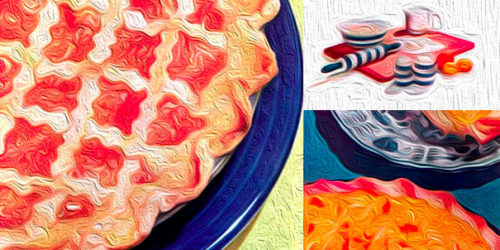
Two years before Dorothy LaBostrie and Little Richard gave us the song, “Tutti Frutti” was just a humble pie filling published to help shoo away readers’ winter blues.
Today, we’re adding a level of time travel to the mix. Bake any of these 1950s pie fillings in a 21st-century pie crust while dancing to versions of “Tutti Frutti” released in the decades between recipes: Elvis Presley (1956), The Jesters (1960), Marc Bolan, Elton John & Ringo Starr (1972), Queen (1986), Alvin and the Chipmunks (1991), Little Richard (Little Richard film, 2000), and Buckwheat Zydeco (2013).
Sunshine Fillings for Winter Pies
Originally published in The Country Gentleman, January 1, 1953
Take your pick from the luscious pies pictured here. Lemon, orange, or grapefruit makes each one a fresh flavor treat.
Double Lemon Pie
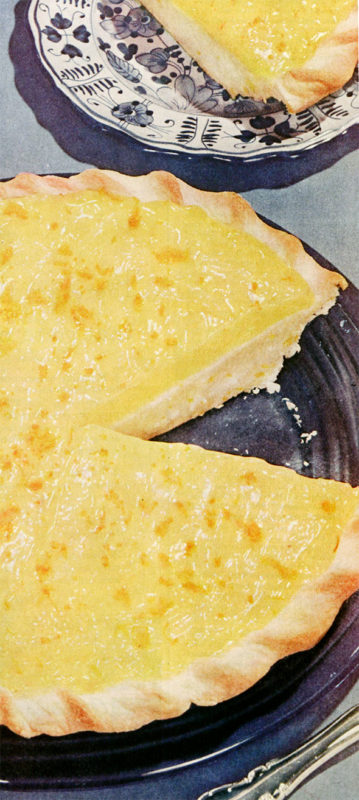
- 2/3 cup sugar
- 2 tablespoons flour
- 1/2 teaspoon salt
- 1 egg yolk
- 1 cup scalded cream
- 1 package unflavored gelatin (2 1/2 teaspoons)
- 1/4 cup cold water
- 1/2 cup lemon juice
- grated rind of 1 lemon
- 1/2 teaspoon vanilla
- 1 baked 9-inch pastry shell
Combine sugar, flour, salt, and egg yolk. Add to scalded cream in top of double boiler. Cook until thick, stirring well. Dissolve gelatin in cold water. Add to hot mixture. Cool. When mixture jells, add lemon juice, rind, and vanilla. Beat egg whites until stiff. Fold into filling. Pile into pastry shell. Chill.
- 3/4 cup sugar
- 3 1/2 tablespoons cornstarch
- 1/4 teaspoon salt
- 3/4 cup water
- juice of 1 lemon
- grated rind of 1 lemon
- 1 egg yolk
- 2 tablespoons butter
Combine all ingredients except egg and butter. Cook and stir until thick. Pour a little over beaten egg yolk. Return to hot mixture. Cook 5 minutes. Add butter. Cool and spread over filling.
Apricot-Orange Marmalade Pie
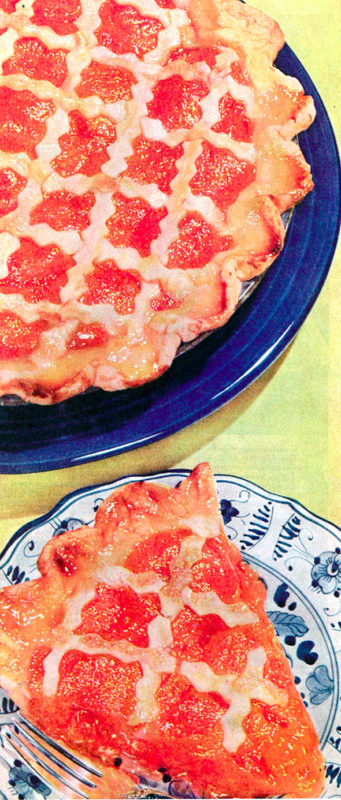
- 3 cups cooked, unsweetened dried apricots (or canned apricots)
- 1 cup orange marmalade
- 1/4 cup apricot juice
- 1 tablespoon quick-cooking tapioca
- 1/8 tablespoon salt
- pastry for 9-inch pie
Drain apricots. Combine marmalade, juice, tapioca and salt. Pour over apricots and mix. Pour into unbaked pie shell. Top with lattice. Bake in hot oven (425° F) 10 minutes. Reduce heat to 350° F and bake 30 minutes.
Orange-Raisin Pie
- 2 cups seedless raisins
- 3 tablespoons lemon juice
- 3/4 cup sugar
- 1/2 cup water
- 2 tablespoons butter
- 3 tablespoons flour
- 1/4 teaspoon salt
- 1 1/2 cups orange sections
- pastry for 2-crust pie
Mix raisins, lemon juice, sugar, and water in a saucepan. Simmer slowly for 15 minutes, or until raisins are plump. Melt butter. Add flour and salt, beating until smooth. Gradually add some of the hot juice from the raisin mixture to the flour, stirring until smooth. Pour into raisin mixture, and cook until thickened. Add orange sections. Pour into pastry-lined 9-inch pie pan. Top with pastry and brush with milk. Bake in a hot oven (425°F) 10 minutes. Reduce temperature to 350° F and bake 25 to 30 minutes.
Orange-Cake Pie
- 1/3 cup butter
- 3/4 cup sugar
- 1 1/2 tablespoons grated orange rind
- 3 eggs, separated
- 1/3 cup orange juice
- 3 tablespoons lemon juice
- 3/4 cup sifted flour
- 1/4 teaspoon soda
- 1/2 teaspoon salt
- 1/2 cup light cream
- 1/4 teaspoon cream of tartar
- 1 lightly baked 9-inch pie shell
Cream butter and sugar together. Add orange rind and egg yolks, beating well. Add orange and lemon juice, flour, soda, and salt, beating until smooth. Add cream, mixing thoroughly. Beat egg whites and cream of tartar together until stiff peaks are formed. Carefully fold egg whites into flour mixture. Pour into pie shell. Bake in a slow oven (325° F) 40 minutes, or until firm.
Tutti-Frutti Pie
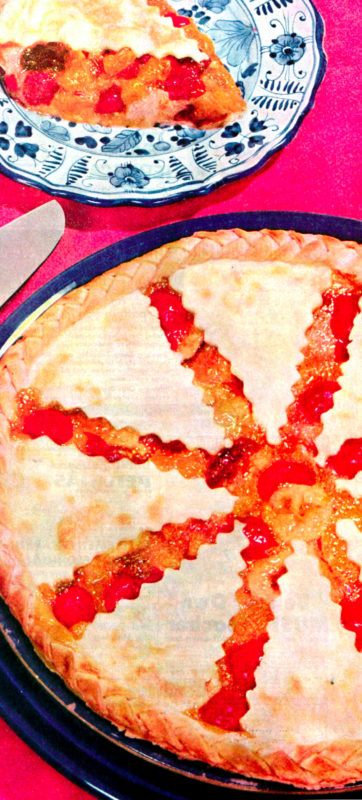
- 1 cup grapefruit sections
- 1 1/2 cups orange sections
- 1/2 cup crushed pineapple
- 1 medium banana, sliced
- 1/2 cup maraschino cherries, halved
- 2/3 cup sugar
- 3 tablespoons quick-cooking tapioca
- 1/4 teaspoon salt
- pastry for 9-inch pie
Combine all ingredients except pastry and butter. Pour into unbaked pie shell. Dot with butter. Top with pastry. Bake in hot oven (425° F) 10 minutes. Reduce heat to 350° F. Bake 40 minutes.
Cover Collection: Time for Pie
Pie follows closely on the heels of turkey as the quintessential Thanksgiving dish. Here are our favorite covers featuring pies — plus recipes — to inspire your pursuit of pastry.
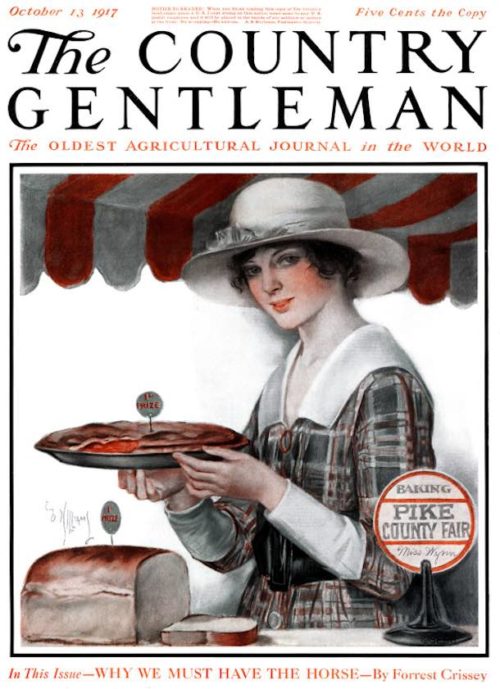
J.L.S. Williams
October 13, 1917
Country Gentleman was a sister publication of The Saturday Evening Post that offered no end of practical advice for farmers and their families. It helped with questions of wintering bees, pruning orchards, and raising hogs. It also featured some pretty delicious pie recipes.
Squash Pie (1917)
1 ½ cupfuls of squash steamed or boiled soft
1 pint of milk
1 cupful of sugar
2 egg yolks
grated rind of half a lemon
2 level tablespoonfuls of cornstarch, moistened with milk
1 cupful of shredded coconut
This recipe is sufficient for two pies. The crusts should be baked separately, first pricking them with a fork to prevent puffing. Mash the squash smooth; add the milk, hot; stir in the sugar, grated lemon rind, cornstarch and yolks of eggs, and boil four minutes, stirring slowly. When nearly cool, fill the baked crusts and sprinkle with shredded coconut.

Norman Rockwell
August 18, 1928
Like Rockwell’s best loved paintings, this one tells a story. A pie was cooling on a window sill and a passing stranger down on his luck couldn’t resist the wonderful aroma. The pie-owner’s dog, however, was having none of it.
Hawaiian Pineapple Fruit Pie (1928)
1 pastry shell
4 slices Hawaiian Pineapple
8 halved peaches
9 prunes
1 cup cream filling
3/4 cup cream, whipped
Spread cream filling lightly in bottom of pastry shell. Steam and stone 9 prunes and arrange on peaches, alternately with pineapple halves. Place prune in the center and garnish with whipped cream. One cup whipped cream may be used instead of cream filling.
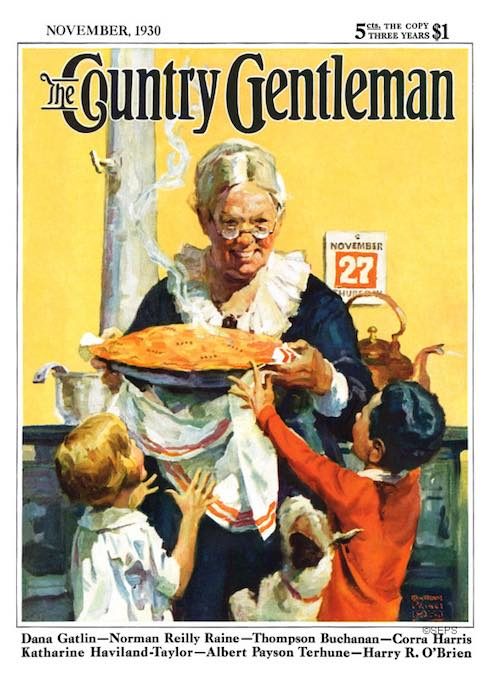
William Meade Prince
November 1, 1930
William Meade Prince was a prolific illustrator who created art for many magazines, illustrated the African American stories of Roark Bradford, made posters for the USO and other organizations during World War II, and created the comic strip “Aladdin, Jr.” He also drew one delicious looking pie.
Lemon Pie (1930)
Rich lemon pie calls for six eggs, but the pie is a large one and unusually fine. Cream half a cupful of softened butter with three-quarters of a cupful of granulated sugar and add the well-beaten yolks of six eggs, a quarter of a teaspoonful of salt and one tablespoonful of fine cracker crumbs, the grated rind of two lemons and the stiffly beaten whites of three eggs. Mix the juice of three lemons with three-quarters of a cupful of granulated sugar and add three tablespoonfuls of cold water, stir into the other mixture and bake in one large pastry-lined pie pan or in individual pie pans. Make a meringue of the other three egg whites and six tablespoonfuls of granulated sugar, add one teaspoonful of lemon juice and spread over the cooled pie. Brown very delicately.
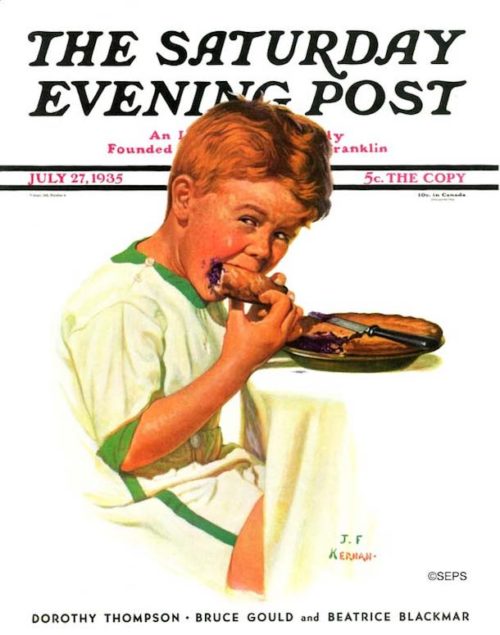
J.F. Kernan
July 27, 1935
J.F. Kernan specialized in images of middle-class life for popular magazines from the 1910s to the 1940s. His nostalgic and often humorous illustrations celebrate the simple comforts of home, family, and outdoor recreation. In this case, who needs a fork or plate when blueberry pie is calling your name? We’re betting that white tablecloth and play suit won’t stay white for long.
Blueberry Flummery (1913)
A cupful of water, a quart of blueberries, a cupful of sugar, three tablespoonfuls of lemon juice, a few grains of salt and half a cupful of cornstarch wet in half a cupful of cold water. Add water to the blueberries and bring them to the boiling point, simmering until soft. Then add salt and sugar and, when well dissolved, the cornstarch. Cook over hot water for twenty minutes, add the lemon juice and pour into molds. Chill and serve with cream.
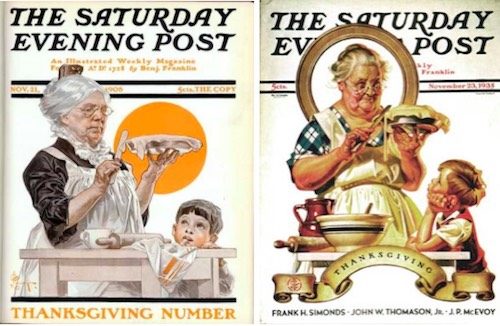
J.C. Leyendecker
November 21, 1908 and November 23, 1935
J.C. Leyendecker, the Post’s most prolific artist with 322 covers to his name, painted this scene more than once. Here we see both the 1908 and 1935 versions of a little boy watching his grandmother trim the pie. The grandma had evolved from stern Victorian to “Aunt Bee,” but not much else in the scene had changed.
Apple Marshmallow Pie (1931)
Pare and slice six well-flavored large apples and simmer till tender in a sirup of half a cupful of sugar and a quarter of a cupful of water. Add a very little nutmeg, cinnamon or grated lemon rind, cool, turn into a baked pastry shell, and top with marshmallows. Place in the oven to brown delicately. Serve with cream. Marshmallow whip or whipped cream may top the pie; in that case browning will be omitted.
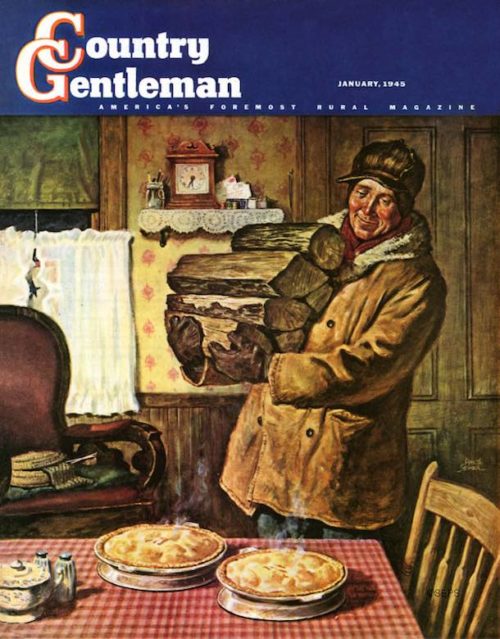
Amos Sewell
January 1, 1945
Although artist Amos Sewell and his wife never had children, many of his 57 Post covers featured kids getting into shenanigans. This country gentleman looks as if he thinking about causing some pie-eating mischief himself.
Apple-Sponge Pie (1932)
Take two tablespoonfuls of butter and rub into it three tablespoonfuls of flour and half a teapsooonful of baking powder. Then add the well-beaten yolks of three eggs, one cupful of apple sauce sweetened, and flavor as you fancy with nutmeg or cinnamon or grated lemon rind. Lastly fold in the stiffly beaten whites of the three eggs and pour into a pan lined with your favorite recipe and bake as you do all custards – a hot oven first to cook the crust quickly – then a slow oven to set the custard. The result is a lovely puffy spongy something which will literally melt in your mouth.
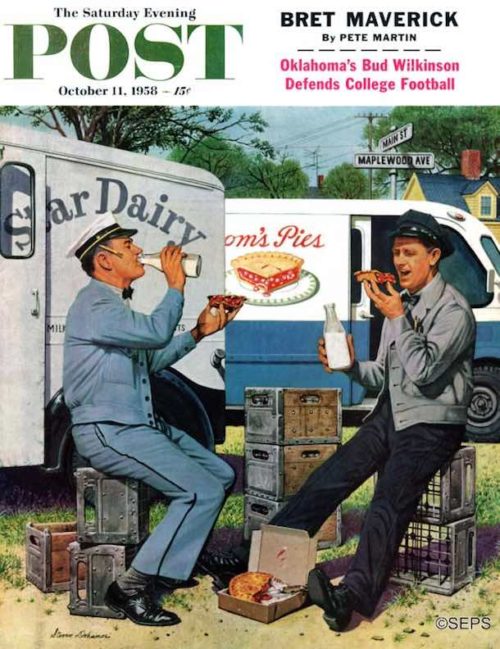
Stevan Dohanos
October 11, 1958
Cherry Betty (1913)
Ten slices of buttered bread, a quart of pitted cherries stewed in a cupful of water and a cupful of sugar. Arrange alternately in a baking dish, cover and bake covered thirty minutes, sifting on the top a fourth of a cupful of brown sugar mixed with half a teaspoonful of cinnamon and a few small pieces of butter during the last ten minutes of the cooking.
Pumpkin Pie and I
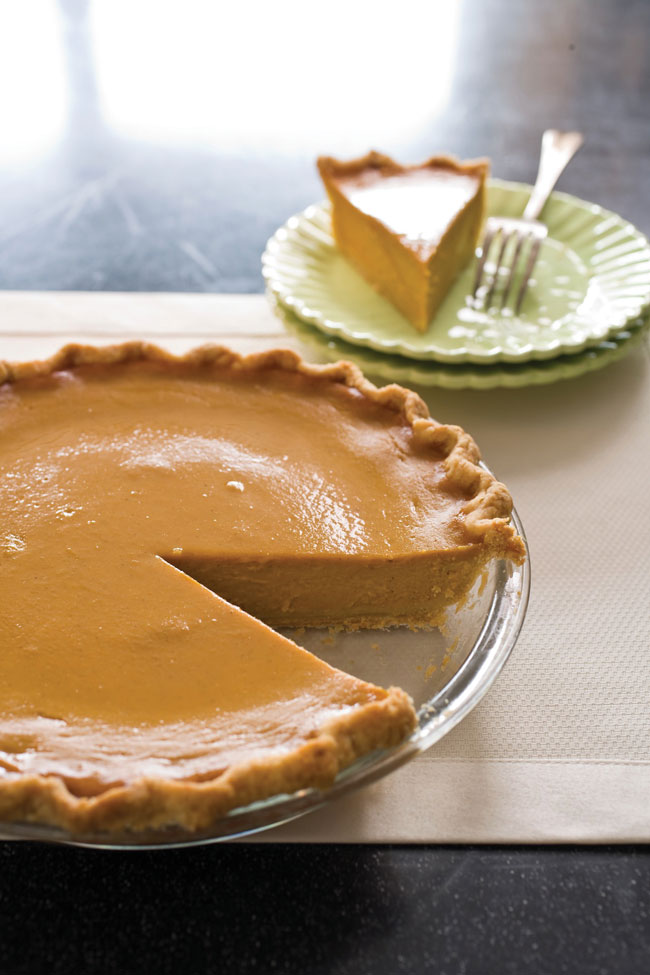
Every girl has one — that guy that she’s “just friends” with. You’ve known each other for I-don’t-know-how-many years, but you’ve never once been attracted, because you’ve always been, and always will be, “just friends.” All your best friends and family love him. You don’t not like him. You want to like him. But there’s something missing. That spark. That je ne sais quoi.
Pumpkin pie is like that guy. I don’t love pumpkin pie, but I so desperately want to. I love all things pumpkin. I love cinnamon, cloves, ginger, and nutmeg with pumpkin in breads, muffins, and pancakes.
I like pumpkin pie. When it’s around, I eat it without thinking twice. I mean, it’s still a pie. I’ll even eat leftover pumpkin pie sitting in the refrigerator; not even bothering to remove the pie from that middle shelf because I’ve contorted my body to prop open the refrigerator door while I sneak five or six bites straight from the pie dish with my fork.
Still, it drives me mildly insane trying to understand why other people go bonkers over pumpkin pie. Usually, the crust looks and tastes like soggy cardboard, and the filling, which can be wonderfully fragrant and flavorful, has the mealy, squishy consistency of baby food.
I want to love pumpkin pie. I want to look forward to the prospect of it with eager, heart-pounding anticipation as soon as the calendar flips from September to October. Pumpkin pie comes around only once a year, and I want a spring and summer absence to make my heart grow fonder. But it doesn’t. And then something happened. I ran into a recipe from Cook’s Illustrated for the perfect pumpkin pie. It promises a flaky, crisp crust. It promises a smooth, delicious, and firm filling. I baked it, unsure of how I’d end up feeling.
After a little more effort than the Libby’s-like recipes we’re used to, I slipped it gently into the oven. When it came out, I let it cool down. I pierced through that soft, quivering custard with an 8-inch chef’s knife and pulled out a perfect, enormous piece. It was heavy. I put the piece on a plate, and I took a bite.
After all these years, I finally fell in … like. A very, very strong like. The spark was finally lit. Pumpkin pie and I? There’s a little something going on between us now.
Pumpkin Pie
Recipes courtesy America’s Test Kitchen
(Makes 8 servings)
Make sure to buy unsweetened canned pumpkin; avoid pumpkin pie mix. If candied yams are unavailable, regular canned yams can be substituted. When the pie is properly baked, the center 2 inches of the pie should look firm but jiggle slightly. The pie finishes cooking with residual heat; to ensure that the filling sets let it cool at room temperature and not in the refrigerator.
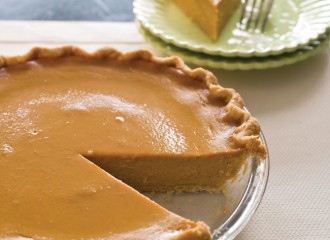
Ingredients
-
1 cup heavy cream
1 cup whole milk
3 large eggs plus 2 large yolks
1 teaspoon vanilla extract
1 (15‑ounce) can unsweetened pumpkin puree
1 cup candied yams, drained
¾ cup (5 ¼ ounces) sugar
¼ cup maple syrup
2 teaspoons grated fresh ginger
1 teaspoon salt
½ teaspoon ground cinnamon
¼ teaspoon ground nutmeg
1 recipe single-crust pie dough, fully baked and still warm (recipe on right)
Directions
-
Adjust oven rack to lowest position and heat oven to 400°F.
Whisk cream, milk, eggs, and yolks, and vanilla together in bowl.
Bring pumpkin puree, yams, sugar, maple syrup, ginger, salt, cinnamon, and nutmeg to simmer in large saucepan and cook, stirring constantly and mashing yams against sides of pot, until thick and shiny, 15 to 20 minutes.
Remove saucepan from heat and whisk in cream mixture until fully incorporated.
Strain mixture through fine-mesh strainer into bowl, using back of ladle or spatula to press solids through strainer. Whisk mixture, then pour into warm prebaked pie crust.
Place pie on rimmed baking sheet and bake for 10 minutes. Reduce oven temperature to 300°F and continue to bake until edges of pie are set and center registers 175°F, 20 to 35 minutes longer.
Let pie cool on wire rack to room temperature, about 3 hours. Serve.
Foolproof Single-Crust Pie Dough
(Makes one 9‑inch pie crust)
Vodka is essential to the tender texture of this crust and imparts no flavor — do not substitute water. This dough is moister than most standard pie doughs and will require lots of flour to roll out (up to 1/4 cup). A food processor is essential for making this dough — it cannot be made by hand.
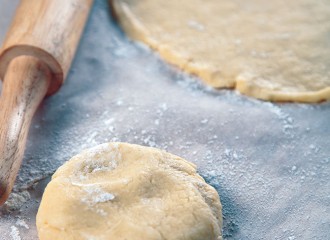
Ingredients
-
1 1/4 cups (6 ¼ ounces) all-purpose flour
1 tablespoon sugar
½ teaspoon salt
6 tablespoons (3/4 stick) unsalted butter, cut into 1/4‑inch pieces and chilled
4 tablespoons (1/4 cup) vegetable shortening, cut into 2 pieces and chilled
2 tablespoons vodka, chilled
2 tablespoons ice water
Directions
- Process 3/4 cup flour, sugar, and salt in food processor until combined, about 5 seconds. Scatter butter and shortening over top and continue to process until incorporated and mixture begins to form uneven clumps with no remaining floury bits, about 10 seconds.
Scrape down bowl and redistribute dough evenly around processor blade. Sprinkle remaining ½ cup flour over dough and pulse until mixture has broken up into pieces and is evenly distributed around bowl, 4 to 6 pulses. Transfer mixture to medium bowl. Sprinkle vodka and ice water over mixture. Stir and press dough together, using stiff rubber spatula, until dough sticks together.
Turn dough onto sheet of plastic wrap and flatten into 4‑inch disk. Wrap tightly in plastic and refrigerate for 1 hour. Before rolling out dough, let it sit on counter to soften slightly, about 10 minutes. (Dough can be wrapped tightly in plastic and refrigerated for up to 2 days or frozen for up to 1 month. If frozen, let dough thaw completely on counter before rolling it out.)
Adjust oven rack to middle position and heat oven to 425°F. Roll dough into 12‑inch circle on floured counter. Loosely roll dough around rolling pin and gently unroll it onto 9‑inch pie plate, letting excess dough hang over edge. Ease dough into plate by gently lifting edge of dough with your hand while pressing into plate bottom with your other hand. Leave any dough that overhangs plate in place. Wrap dough-lined pie plate loosely in plastic and refrigerate until dough is firm, about 30 minutes.
Trim overhang to ½ inch beyond lip of pie plate. Tuck overhang under itself; folded edge should be flush with edge of pie plate. Crimp dough evenly around edge of pie plate using your fingers. Wrap dough-lined pie plate loosely in plastic and refrigerate until dough is fully chilled and firm, about 15 minutes, before using. Line chilled pie shell with parchment paper or double layer of aluminum foil, covering edges to prevent burning, and fill with pie weights.
For a partially baked crust: Bake until pie dough looks dry and is pale in color, about 15 minutes. Remove weights and parchment and continue to bake crust until light golden brown, 4 to 7 minutes longer. Transfer pie plate to wire rack. (Crust must still be warm when filling is added.)
For a fully baked crust: Bake until pie dough looks dry and is pale in color, about 15 minutes. Remove weights and foil and continue to bake crust until deep golden brown, 8 to 12 minutes longer.
Per Serving
Calories: 545
Total Fat: 31 g
Saturated Fat: 16 g
Sodium: 597 mg
Carbohydrate: 60 g
Fiber: 4 g
Protein: 8.4 g
Diabetic Exchanges: 4 carbohydrate, 6 fat
Cook the Pumpkin
To maximize flavor, we at America’s Test Kitchen, publisher of Cook’s Illustrated, concentrate the pumpkin’s liquid rather than remove it, and we’ve found it best to do this on the stove — an added bonus for the spices that we add to the filling as well. Cooking the fresh ginger and spices along with the pumpkin puree intensifies their taste — the direct heat blooms their flavors. Cooking minimizes the mealy texture in this pie where pumpkin is the star.
Supplement with Yams
When we used solely pumpkin puree, we craved more flavor complexity. We experimented with roasted sweet potatoes, which added a surprisingly deep flavor without a wholly recognizable taste. To streamline this technique, we tried adding canned sweet potatoes — often labeled yams — instead. The yams add a complex flavor that complements the pumpkin.
Add Extra Yolks
Our goal with this pie was to eliminate the grainy texture that plagues most custard in favor of a creamy, sliceable, not-too-dense pie. We start with a balance of whole milk and cream, and firm up the mixture with eggs. We don’t simply add whole eggs, though — that just makes the pie too eggy. Because the whites are filled with much more water than the yolks, we exchange some whole eggs for yolks alone. Don’t forget to pass mixed filling through a fine-mesh strainer. This will ensure the ultimate smooth texture.
Add Hot Filling to Warm Crust
If you’re tempted to bake the pie crust way ahead of time, don’t. It’s imperative that the pie crust is warm when you add the hot filling. If it is not, the pie will become soggy. Using a hot filling in a warm crust allows the custard to firm up quickly in the oven, preventing it from soaking into the crust and turning it soggy. Keep that crust warm!
Turn the Oven High to Low
Most pumpkin pie recipes call for a high oven temperature to expedite cooking time. But as we’ve learned, baking any custard at high heat has its dangers. Once the temperature of custard rises above 185°F it curdles, turning the filling coarse and grainy. This is why we cannot bake the pie at 425°F, as most recipes suggest. Lowering the temperature to 350°F only produces a pie that is curdled and overcooked at the edges and still underdone in the center. But baking at a low 300°F would mean leaving the pie in the oven for 2 hours. What to do? We combine the two techniques, blasting the pie for 10 minutes on high heat and then baking it at 300°F for the rest of the baking time. This lessens the cooking time exponentially and leaves us with a creamy pie that’s fully and evenly cooked from edge to center.
Pear-Caramel Pie
This is a wonderfully comforting fall and winter pie. Pears spiced lightly with cinnamon and ginger are made all the richer by brown sugar and homemade caramel. Make the caramel first so that it has time to cool. Any leftover caramel can be used to garnish each slice of pie or save for future use. The caramel will keep for one week at room temperature in an airtight container or in the refrigerator for a few weeks.
Pear-Caramel Pie
(Makes one 9-inch double-crust deep-dish pie)
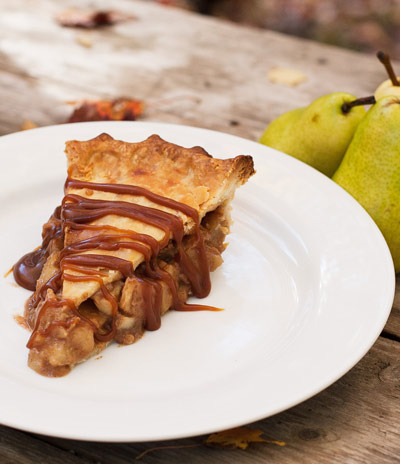
Ingredients
Crust
Caramel
- 10.5 ounces granulated sugar
- 4 ounces water
- 9.65 ounces heavy cream
- 1.75 ounces unsalted butter, cubed, softened
Filling
- 3 pounds pears, peeled and medium diced
- 5 ounces brown sugar
- 2 ½ teaspoons ground cinnamon
- ¼ teaspoon ground nutmeg
- 1 teaspoon ground ginger
- ½ teaspoon fine sea salt
- 6 tablespoons all-purpose flour
Egg wash
- 1 beaten egg and a splash of water
Directions
- For crust, roll dough into 2 circles about 12 inches in diameter. Bottom piece should be a little bit bigger, to cover pie dish. Fit bottom into dish and chill until ready to put filling in and top it. Chill top piece as well until ready to assemble pie.
- For caramel, combine sugar and water in large very clean saucepan over high heat. Make sure all utensils used are very clean as impurities can cause caramel to crystallize. Stir with spatula to dissolve sugar. Have pastry brush and cup of water ready to wash down sides of pot. Bring mixture to a boil. Once boiling, wash down sides of pot periodically to prevent crystallization. It should become a deep amber/caramel, which is about 325˚F on a candy thermometer.
- When caramel is right color, slowly whisk cream into sugar syrup, being very careful to avoid steam that will burst up toward your hand. Continue to cook caramel for 2 minutes. Remove pot from heat and stir in butter.
- For filling, peel and cut fruit. Combine with all dry ingredients, tossing until evenly coated. Allow fruit to sit for 30 minutes.
Assembling Pie
- Preheat oven to 450°F
- Pull pie dish and top circle of pie from fridge. Trim overhanging edge of bottom crust with knife.
- Toss fruit again, and then pour it all into pie dish. Pour 1 cup caramel evenly over top of fruit.
- Egg wash rim of bottom crust lightly, and then put on top piece. Crimp edge of pie to seal it. Create a decorative edge by putting thumb and index finger of nondominant hand together and pressing dough together. Press dough into that wedge with other index finger in order to create a point. Do this around entire rim of pie.
- Cut 6 evenly spaced slits on top piece of pie, and egg wash top and edge. Place directly on baking stone, and bake for 1 hour. Top needs to be a deep golden brown and filling should be bubbling. If taking too long, raise pie up on rack so that it gets more direct heat. It may take another 10 minutes to bubble and color. Remove pie from oven and cool for 6 hours or more before serving to allow filling to set.
- Serve warm or at room temperature. Drizzle extra caramel on top when plating each piece. Boom!
Recipe and photo from Baking By Hand: Make the Best Artisanal Breads and Pastries Better Without a Mixer by Andy and Jackie King.